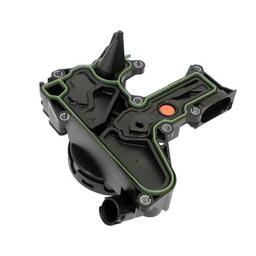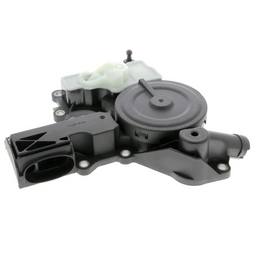The EA888 engine series has garnered significant acclaim in the automotive industry for its impressive performance and good overall reliability. However, not all components have proven to be as reliable as the engine itself. One such component that plays a vital role in the engine’s overall performance is the Positive Crankcase Ventilation (PCV) system.
In this blog post, we will explore the common PCV issues encountered by EA888 engines and provide comprehensive explanations for each. By understanding these issues and their underlying causes, drivers and enthusiasts can proactively address them, ensuring optimal engine health and performance.

Understanding the PCV System
The Positive Crankcase Ventilation (PCV) system is a vital component of the EA888 engine series, playing a crucial role in maintaining engine health and performance. To grasp the significance of PCV issues in EA888 engines, let’s delve into the workings of this system.
The PCV system consists of several key components, including the PCV valve and the breather system. Its primary function is to regulate the ventilation of the engine’s crankcase, which is the chamber containing the crankshaft and other moving parts. By controlling the flow of gases and vapors within the crankcase, the PCV system ensures proper pressure levels and prevents the buildup of harmful substances.
The PCV valve acts as the heart of the system, regulating the flow of gases between the crankcase and the intake manifold. Under normal operating conditions, the PCV valve allows the engine to draw fresh air from the intake manifold into the crankcase, which helps remove harmful gases, moisture, and combustion byproducts. This process not only maintains the integrity of engine oil but also prevents excessive pressure from building up inside the crankcase.
The breather system complements the PCV valve by providing additional ventilation for the crankcase. It typically consists of breather hoses, filters, and other components that allow filtered air to enter the crankcase and prevent the entry of contaminants such as dirt and debris.
Together, the PCV valve and breather system ensure that the engine operates with optimal crankcase pressure, reduces the risk of oil contamination, and maintains proper lubrication throughout the engine’s various components.
Common PCV Issues in EA888 Engines
When the PCV valve fails, it causes a number of issues. Some of them are more apparent than others, but most will lead to some sort of engine performance problem. Here’s the list of most common PCV related issues you could run into.
Excessive Oil Consumption
One of the most prevalent PCV issues in EA888 engines is excessive oil consumption. A faulty PCV system can disrupt the engine’s oil management, leading to increased oil usage and the need for more frequent oil top-ups. Several factors can contribute to this problem, including clogged or stuck PCV valves, worn-out seals, or malfunctions in the breather system.
Excessive oil consumption not only leads to more frequent oil changes but can also have adverse effects on engine performance and longevity. Insufficient lubrication due to engine oil loss can result in increased friction, heat buildup, and premature wear of engine components. It’s important to keep an eye out for symptoms such as low oil levels between oil changes, the presence of blueish smoke in the exhaust, or oil leaks, as these may indicate excessive oil consumption related to PCV issues.
Rough Idling and Misfires
PCV problems can also manifest as rough idling and engine misfires in EA888 engines. When the PCV system malfunctions, excessive crankcase pressure can disrupt the air-fuel mixture, leading to an uneven combustion process. This can cause the engine to idle roughly and experience intermittent misfires, where one or more cylinders fail to ignite properly.
Rough idling is characterized by a noticeable vibration or instability in the engine’s idle speed. Misfires, on the other hand, may result in a loss of power, hesitation during acceleration, or a rough running engine. If you encounter these symptoms consistently, it’s essential to consider the PCV system as a potential cause.
Oil Leaks and Contamination
Faulty PCV components can also contribute to oil leaks and contamination in EA888 engines. When the PCV system fails to regulate crankcase pressure effectively, it can lead to pressure imbalances that cause oil to leak from gaskets, seals, or other engine components.
Oil leaks not only create unsightly stains in your engine bay but can also have more serious consequences. Oil acts as a vital lubricant, protecting various engine parts from friction and wear. When oil leaks occur, the affected components may not receive adequate lubrication, leading to increased friction and potential damage. Additionally, oil contamination can occur when unfiltered air or other contaminants enter the crankcase, compromising the quality and effectiveness of the engine oil.
Keeping an eye out for oil spots under your vehicle, the smell of burning oil, or signs of oil contamination, such as sludge buildup or discolored oil, can help identify PCV-related oil leak and contamination issues in EA888 engines.
In the next section, we will discuss methods for diagnosing PCV issues in EA888 engines, allowing you to identify and address these problems promptly.
Diagnostic Codes Associated with PCV Failure on EA888 Engines
Diagnostic codes associated with PCV failure in EA888 engines can vary depending on the specific issue and the vehicle’s make and model. However, here are some common diagnostic trouble codes (DTCs) that can indicate PCV-related problems in EA888 engines:
- P0171 – System Too Lean (Bank 1): This code indicates that the air-to-fuel mixture in Bank 1 is too lean. It can be triggered by PCV system leaks or malfunctions that lead to excessive air entering the engine.
- P0172 – System Too Rich (Bank 1): This code indicates that the air-to-fuel mixture in Bank 1 is too rich. It can be caused by PCV system blockages or malfunctions that disrupt the proper flow of gases and affect the air-fuel mixture.
- P0174 – System Too Lean (Bank 2): Similar to P0171, this code indicates a lean air-to-fuel mixture, but for Bank 2. It can also be caused by PCV system issues.
- P0175 – System Too Rich (Bank 2): Similar to P0172, this code indicates a rich air-to-fuel mixture, but for Bank 2. PCV system problems can contribute to this code.
- P0507 – Idle Air Control System RPM Higher than Expected: This code indicates that the engine’s idle speed is higher than expected. PCV system malfunctions can affect the air-fuel mixture and lead to abnormal idle speed.
- P2187 – System Too Lean at Idle (Bank 1): This code indicates a lean air-to-fuel mixture at idle in Bank 1. PCV system issues can contribute to this code.
These are just a few examples of diagnostic trouble codes associated with PCV failure in EA888 engines.
What Goes Wrong with the EA888 PCV Valve?
The PCV valve design on the EA888 engine is fairly simple, despite its appearance. Volkswagen/Audi has had a few issues with their original design, which is why there are numerous iterations of the PCV valve available on the market. When replacing yours, make sure to get the latest iteration that fits your engine.
That said, there are several things that tend to fail on this PCV valve. In most cases, you are looking at issues with the rubber diaphragm located under the circular cap on the PCV or the orange check valve.
Rubber Diaphragm Tearing
If you look at the PCV valve assembly, you’ll notice a round cap on top. Behind that cap is a rubber diaphragm that’s sitting on top of a spring-loaded mechanism. When this diaphragm tears, it breaks the seal and starts sucking in the air. The amount of air that gets through depends on the size of the tear.
Sometimes it’s a small leak, but sometimes it will let in so much air that you’ll hear a whistling sound coming from the PCV assembly. One easy way to test the diaphragm is to cover the bleeder hole located on the right side of the round cap. If doing so calms the idle, or stops the whistling noise, chances are that your PCV valve is ready for replacement.
Check Valve Issues
If you were to remove the PCV valve assembly, you’d see an orange check valve. This check valve opens and closes as the conditions within the system change. Over time, this valve can get stuck, causing the entire PCV valve to essentially fail.
Other Causes
Another thing that can sometimes happen and cause PCV valve failure is gasket deterioration. When you remove the PCV valve assembly, there’s a green gasket around the perimeter of the plastic housing. If this gasket fails, it can cause a leak.
How to Fix the PCV Valve on EA888 Engine?

Fixing the PCV valve usually implies replacing the entire unit. Fortunately, this is a simple DIY project that you can do on your own. Keep in mind that this procedure may vary depending on the exact version of the EA888 that’s in your car. That said, most of the steps apply across the board. Here’s how to do it.
Step 1 – Remove the Engine Cover
First, you’ll want to remove the plastic engine cover. It’s held in place by several clips that will come right off if you pull on the cover with some conviction. With the cover off, focus on the ignition coil harness.
Step 2 – Remove the Ignition Coil Harness
Next, you’ll need to undo the ignition coil harness connectors, which will allow you to get the harness out of the way. Each connector is secured to the ignition coil using a plastic tab. Push on the tab and remove all 4 connectors.
With the harness out of the way, go ahead and remove cylinder 3 and cylinder 4 ignition coils as they are in the way.
Step 3 – Detach the Breather Hose
The next step involves detaching the breather hose that connects the PCV valve to the intake manifold. The hose is secured in place using two plastic tabs. Push on these tabs and slowly work the hose away from the PCV valve.
Step 4 – Remove the 9 T30 Torx Screws
This part is self-explanatory. There are 9 T30 Torx screws that secure the PCV valve to the engine. Remove them and set them aside. With the PCV valve now loose, disconnect the rear PCV hose.
At this point, you can take your new PCV valve and install it by reversing the removal procedure. Make sure to clean up any oil residue left behind on your old PCV valve.
Use the Latest Version of the PCV Valve for Your Car
As mentioned earlier, Volkswagen/Audi has updated the PCV valve design over the years. When sourcing the right part, make sure that you’re getting the latest version available for your EA888 model. Check our catalog for a selection of Volkswagen/Audi PCV valves!
Find the latest version of the PCV valve for your car!
Fix Your EA888 PVC Valve Today!
In conclusion, understanding and addressing PCV issues in the EA888 engine series is crucial for maintaining engine health, performance, and longevity. The PCV system plays a vital role in regulating crankcase ventilation, preventing excessive pressure buildup, and ensuring the integrity of engine oil.
Browse our catalog and find a reliable replacement PVC valve that is a guaranteed fit for your EA888 engine.





